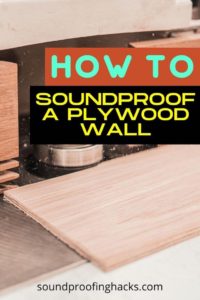A person’s home is their sanctuary but what can you do when your former paradise becomes a noise-ridden nightmare?
 Maybe road noise is constantly keeping you up at night or perhaps simply you got unlucky with your choice of rowdy neighbors.
Maybe road noise is constantly keeping you up at night or perhaps simply you got unlucky with your choice of rowdy neighbors.
Or it could be that you have a shed where you relax and spend time doing your hobbies, but it became too noisy to concentrate as the plywood walls are simply not blocking out any noise.
Or it could be a utility closet where the HVAC machines are starting to make weird noises.
Nevertheless, you’ve got a couple of options to keep out the ruckus without too much fuss.
Primarily, you can try soundproofing your walls but the material they’re built from plays a significant factor.
In this post, let’s take a closer look at how to soundproof a plywood wall and the options you have.
Contents: Skip to section
Drywall vs Plywood
While you can’t necessarily pick what your walls are made of, understanding the soundproofing limitations of different materials will save you some frustration in the long run.
Sound travels through vibrations, either through the air or solid surfaces.
Some materials, such as fiberglass, are efficient noise insulators that absorb these vibrations, limiting their propagation.
However, whereas drywall also has great soundproofing capabilities, plywood won’t offer nearly as much noise reduction due to its composition.
Plywood is made with several thin layers of wood that are stacked together into a single piece yet wood is inherently a poor noise barrier since sounds travel through it quite easily.
Perhaps this is why you can hear your neighbors’ television blasting right through the walls at 3 AM, but that doesn’t mean there isn’t anything you can do to prevent this.
You’ll just have to use materials with better noise reduction properties to get the job done.
How to soundproof a plywood wall: What’s your budget?
When it comes to soundproofing a wall, there are quite a few choices at your disposal, depending on your budget and the amount of effort you want to put into the project.
Some options are fast fixes that won’t make you needlessly break a sweat or cost you a pretty penny.
Still, you get what you pay for, and the more you invest in soundproofing your walls, the better quality noise reduction you can expect.
Other methods will be a bit more involved and pricier but, afterward, you’ll be able to sleep better without any more late-night rude awakenings.
Who could argue with that?
Hey, quick one. If you intend to start a soundproofing project soon, check out our Best Materials for Soundproofing post to get a headstart. Most projects require similar materials, so this post will save you a ton of time researching.
The quick, cheap, and easy ways
Quick Summary of the budget friendly ways:
- Soundproof wallpaper
- Foam wallpaper
- Acoustic foam panels
- Fiberglass panels
- Soundproof paint
The fastest way to soundproof your plywood walls would be to put up some soundproofing wallpaper or acoustic foam panels.
Adding layers to your walls will help dampen the noise traveling through them and prevent more vibrations from propagating.
Soundproofing wallpaper is generally made from wallpaper backed by foam or is composed of similar noise-reducing materials.
Foam wallpaper is by far the most common as its stacked layers of polyethylene are also multi-purposed, acting as great sound insulators and thermal radiators.
Not only will acoustic wallpaper help reduce noise from coming into or exiting a room, but it’s also useful for trapping in or blocking out heat in the same manner.
Nowadays, foam wallpaper is available in a myriad of designs, making them both functional and decorative so there’s sure to be one in a pattern that suits your tastes.
I really like that you can kill two birds with one stone and end up with a beautiful wall decor in the process.
Better yet, look out for versions made of fiberglass where available as they’re denser and, thus, provide a better noise reduction.
You can find several styles currently on the market that aren’t too costly but not all acoustic wallpaper was meant to be painted over.
If you’re planning on redecorating down the road or don’t like the wallpaper’s original color, make sure to spend your cash wisely on wallpaper you won’t have to end up replacing.
Here’s a couple of nice options.
Read more: Rockwool vs Fiberglass for Sound Absorption
LEISIME 3D Wall Sticker Self-Adhesive Wall Panels Waterproof PE Foam Wood Veins Wallpaper
Art3d 64 Sq.Ft Peel and Stick 3D Wall Panels for Interior Wall Decor, White Brick Wallpaper
That withstanding, there are two things you must keep in mind when using foam wallpaper.
The first is that the material should never be placed anywhere near an open flame, nor is it ideal for use in bathrooms.
Both heat and humidity will only destroy foam wallpaper over time, either warping or discoloring it, so avoid using it in the kitchen, for example.
It might also be prudent to factor in the size of the room you’re attempting to soundproof.
Buying enough foam wallpaper or acoustic foam panels can quickly ratchet up your home improvement budget if you’re not careful.
Make sure to measure the room and calculate the cost of paneling all the walls versus just the most compromised one.
For individuals on a shoestring budget, foam paneling might be out of the question yet there’s still hope.
You could grab yourself a couple of buckets of soundproofing paint and get to brushing.
Acousti Coat – Sound Deadening Paint
KILZ TRIBUTE Interior Matte Paint and Primer in One
Despite soundproofing paint not being as effective as other methods, it is still another quick way to soundproof a room and is undoubtedly the cheapest, barely costing more than takeout.
For the soundproofing paint to work, you’ll need to liberally apply several coats of paint to the walls, allowing the paint at least a day per layer to dry.
The paint should have no problem sticking to the plywood but you should keep in consideration that removing the paint in the future will be nearly impossible.
Although you could remove the paint with paint thinner when the time comes, the chemical will likely ruin the plywood underneath the paint.
Neither is it guaranteed that the paint thinner will get out the paint that seeped into the wood’s cracks. Only paint if you plan to keep the plywood painted indefinitely, only removing it to replace it with another paint color.
Between the soundproofing wallpaper and soundproofing paint, the former is the clear winner in terms of efficiency.
Still, neither might cut it if you need a serious amount of noise reduction to be able to keep your sanity, especially in a loud neighborhood. If outdoors or in your backyard area, you can build an acoustic fence to handle the problem.
In that case, it might be time to stretch your pocketbook and splurge on some soundproofing heavy hitters that are sure to knock it out of the park.
The most effective ways
Quick summary of the effective ways:
- Soundproof blankets
- Moving blankets
- Mass Loaded Vinyl (MLV)
The following soundproofing method is also the most foolproof, meaning you won’t have to worry about accidentally messing up your plywood walls in its application.
Soundproofing blankets are the next best thing for noise reduction as their thickness makes them very effective noise insulators, thereby providing excellent sound absorption along with thermal insulation.
I’d recommend investing in soundproofing blankets with built-in grommets for hooks since all you’ll need to do then is install two hooks per wall to hang them.
This option won’t damage your walls in any way as the hooks should be drilled right into the corner of the ceiling, a project that shouldn’t take longer than watching a blockbuster.
Audimute Sound Absorption Sheet – Sound Dampening Blanket
Soundproofing blankets can be heavy as they are dense so make sure to adequately account for this when installing the hooks.
The last thing you want is to tear a huge hole in your ceiling because the blanket caused it to collapse so take care to avoid this unfortunate scenario.
Using moving blankets instead of specially-engineered soundproofing blankets is also a novel soundproofing method if you can believe it.
Consider this substitution as a mid-range option which is just as efficacious without a hefty price tag.
However, they won’t come with grommets for hooks.
You can alternatively use a healthy amount of mounting putty to fix the moving blankets to the walls, a substance that’s easily removable for minimal future damage to your plywood walls.
Sure-Max Moving & Packing Blanket
Forearm Forklift FFMB Full Size Medium Weight Quilted Moving Blanket
Soundproofing blankets are one of the best ways to reduce outside noise but if you want to make sure that not even the faintest peep gets in, you’ll need something that packs a bigger punch.
Mass loaded vinyl (MLV) is one of the most efficient noise-insulating products out there, able to block almost any noise source on the other side of your wall like it’s not even there.
The highly-dense material has unquestionably earned its reputation in the soundproofing industry and it comes in a variety of sizes and densities.
Noise Grabber Mass Loaded Vinyl (MLV)
However, multiply the price of a single roll by however much you’ll need to cover all your walls and you might end up spending a small fortune.
MLV is practically guaranteed to eliminate your noise problems, though, and can you really put a price on peaceful bliss in your home?
Probably not, so feel free to mix and match any other these methods as your heart and wallet desires. Tack up some MLV and cover it with a blanket or do the same using paint and acoustic foam panels.
Soundproofing can be expensive, or can be done on a budget. Either way, your ears will be sure to thank you.
Conclusion: How to soundproof plywood wall?
Now that you have seen all the possible methods to reduce noise transmission in your plywood walls, what’s next for you?
Will you be using budget or premium materials to implement your project?
My advice is to proceed step by step. Try out the methods that do not cost much at first. And if sound reduction is a top priority to you, then consider investing in higher priced products later on.
Other interesting reads:
- 4 Best Quiet Drum Set: Practice Silently At Home!
- How To Soundproof Tents: 4 Fast And Effective Ways That Work
- How to soundproof a garage door from the inside? 3 easy ways to get started
- How much does it cost to soundproof a room: Smart ways to save money
- 9 Best Acoustic Partitions: How to choose the right one
- How to Soundproof Barn Doors in 9 Practical Ways
- 6 Best Quiet Pellet Guns 2020
- 5 Best Quiet Drones 2020: Reviews and Guide
- 6 Best Quiet Coffee Grinders (Updated 2020)








